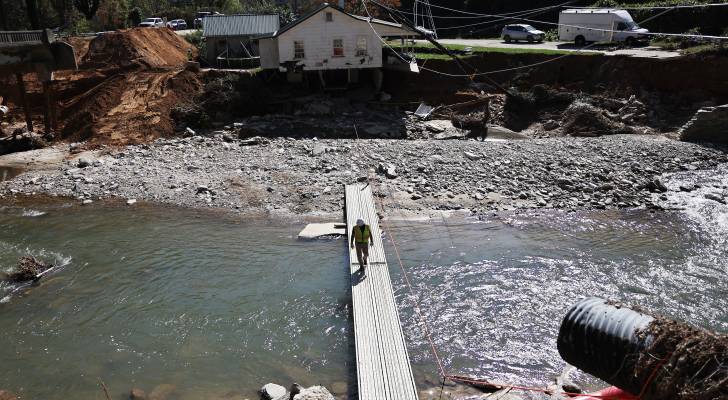
Some Florida homeowners hardest hit by hurricanes Milton and Helene must now also see their homes completely demolished or, if they’re lucky, elevated.
This follows a federal mandate that impacts majorly damaged homes — those impacted by natural disasters. Federal Emergency Management Agency’s (FEMA) 50% rule dictates that if a house is in a flood zone and local building officials deem it to be substantially damaged, straightforward repairs may not be sufficient.
The complex regulation kicks in when the repair costs exceed 50% of the home’s market value (the test for “substantially damaged”), amounting to hundreds of thousands of dollars for the homeowners.
Don’t miss
- I’m 49 years old and have nothing saved for retirement — what should I do? Don’t panic. Here are 5 of the easiest ways you can catch up (and fast)
- Gain potential quarterly income through this $1B private real estate fund — even if you’re not a millionaire. Here’s how to get started with as little as $10
- Thanks to Jeff Bezos, you can now become a landlord for as little as $100 — and no, you don’t have to deal with tenants or fix freezers. Here’s how
The impact of hurricanes Milton and Helene
Hurricane Milton took at least 24 lives in Florida and caused over $34.3 billion in damages last October, while just days prior, Hurricane Helene’s aftermath killed 34 in the state and caused over $78.7 billion in damages across the U.S.
The west coast barrier islands of Pinellas County were one of the state’s most impacted areas. Redington Shores resident Derek Brunney has lived in his home for over 20 years and has had to contend with it being demolished.
“You start seeing different events you had on the property. Weddings, birthdays, things like that. It just rehashed everything," Brunney told WFLA News Channel 8 On Your Side about the aftermath. "It’s one step forward, two, or three steps back. You get punched in the eye at the same time.”
The trouble for many homeowners like Brunney is that they still must pay for their insurance and utilities. But he — and many other Florida homeowners — still hold out hope for a better future.
“It’s slow,” he said. “It’s daunting. It’s exhausting, but it’s the only way you’re going to move forward right now until you get to the end of it.”
How to budget for the unexpected
When it comes to home repairs and rising insurance costs, you often can’t anticipate when they’ll hit. The key is to be prepared. While this isn’t a simple feat for many, there are some practical things you can start doing today to budget for the future and any rebuilding efforts.
Set aside emergency savings. Aim to save what you can each year for emergency repairs and maintenance. Ideally, your fund will cover three months worth of minimum monthly expenses, but if you’re in a disaster-prone area, you’ll need to prepare for more than the bare minimum because such expenses fall beyond the parameters of regular expenses. To get a sense of what you’d need to put away, you can try using a savings goal calculator, or plain old pencil and paper. While those funds sit tight, invest them independently in something that earns interest yet keeps them separate and accessible, like a high-yield savings account.
Read more: Car insurance premiums could spike 8% by the end of 2025 — thanks to tariffs on car imports and auto parts from Canada and Mexico. But here’s how 2 minutes can save you hundreds of dollars right now
Understand your insurance plan and exactly what you are and aren’t covered for. Review your home insurance policy in detail every year, and don’t hesitate to contact your agent to clarify terms. Ask questions. Document answers. Make sure you understand deductibles, exclusions and any limits on claims.
Prepare and save for increased premiums. Track trends in local insurance rates and adjust your budget accordingly. Even if you aren’t in an area of direct impact when it comes to natural disasters like fires and hurricanes, you may be surprised to learn, your premiums may still be going up. Others in “high-catastrophy states” may also need to prepare. Understand why this may be the case, and prepare to shop around for the best rates for the coverage you need, if necessary.
Future-proof your home against natural disasters. Start with small projects like installing storm shutters and sump pumps, reinforcing your roof and replacing lighter materials with more durable alternatives. Then, consider larger upgrades like hurricane resistance or seismic retrofits, and flood barriers. Fireproofing his home made all the difference for this California resident.
Look into state-wide programs to help offset costs. For example, Elevate Florida, the state’s first elevation mitigation program, was designed to "enhance community resilience by mitigating private residences against natural hazards." It provides eligible homeowners with at least 75% of their costs for structure elevation, mitigation reconstruction, acquisition/demolition or wind mitigation. Research and use all the programs and funds available to you.
With these measures, you can rest assured you are being proactive in protecting your home and your future.
What to read next
- Want an extra $1,300,000 when you retire? Dave Ramsey says this 7-step plan ‘works every single time’ to kill debt, get rich in America — and that ‘anyone’ can do it
- Here are 5 ‘must have’ items that Americans (almost) always overpay for — and very quickly regret. How many are hurting you?
- ‘Liberation Day’ just triggered a 60% chance of a US recession, warns JP Morgan — use these ‘anti-shock’ money hacks to protect yourself ASAP
This article provides information only and should not be construed as advice. It is provided without warranty of any kind.